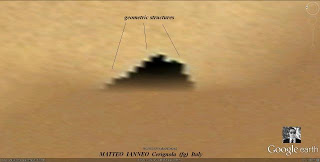

| Visitors Now: | |
| Total Visits: | |
| Total Stories: |
Section of Temple Complex Discovered on Mars?
Discussions concerning all matters of humanity\’s ascension into a higher dimensional existence culminating in 2012
 |
| Remarkable rock formation discovered on Mars |
Discovery by Matteo Ianneo
Story reposted from Beforeitsnews.com
Look at these these pictures,does that look like a natural formation to
you? I didn’t think so either.It kind of looks like some sort
of Ziggurat.
Credit: Wikipedia
Ziggurats were built by the Sumerians, Babylonians, Elamites, Akkadians, and Assyrians
for local religions. Each ziggurat was part of a temple complex which
included other buildings. The precursors of the ziggurat were raised
platforms that date from the Ubaid period[1] during the fourth millennium BC. The earliest ziggurats began near the end of the Early Dynastic Period.[2]
The latest Mesopotamian ziggurats date from the 6th century BC. Built
in receding tiers upon a rectangular, oval, or square platform, the
ziggurat was a pyramidal structure with a flat top. Sun-baked bricks
made up the core of the ziggurat with facings of fired bricks on the
outside. The facings were often glazed in different colors and may have
had astrological
significance. Kings sometimes had their names engraved on these glazed
bricks. The number of tiers ranged from two to seven. It is assumed that
they had shrines at the top, but there is no archaeological evidence
for this and the only textual evidence is from Herodotus.[3]
Access to the shrine would have been by a series of ramps on one side
of the ziggurat or by a spiral ramp from base to summit. The
Mesopotamian ziggurats were not places for public worship or ceremonies.
They were believed to be dwelling places for the gods
and each city had its own patron god. Only priests were permitted on
the ziggurat or in the rooms at its base, and it was their
responsibility to care for the gods and attend to their needs. The
priests were very powerful members of Sumerian society.
One of the best-preserved ziggurats is Chogha Zanbil in western Iran. The Sialk ziggurat, in Kashan, Iran,
is the oldest known ziggurat, dating to the early 3rd millennium BC.
Ziggurat designs ranged from simple bases upon which a temple sat, to
marvels of mathematics and construction which spanned several terraced
stories and were topped with a temple.
An example of a simple ziggurat is the White Temple of Uruk, in ancient Sumer. The ziggurat itself is the base on which the White Temple is set. Its purpose is to get the temple closer to the heavens,[citation needed]
and provide access from the ground to it via steps. The Mesopotamians
believed that these pyramid temples connected heaven and earth. In fact,
the ziggurat at Babylon was known as Etemenankia or “House of the
Platform between Heaven and Earth”.
An example of an extensive and massive ziggurat is the Marduk ziggurat, or Etemenanki,
of ancient Babylon. Unfortunately, not much of even the base is left of
this massive structure, yet archeological findings and historical
accounts put this tower at seven multicolored tiers, topped with a
temple of exquisite proportions. The temple is thought to have been
painted and maintained an indigo
color, matching the tops of the tiers. It is known that there were
three staircases leading to the temple, two of which (side flanked) were
thought to have only ascended half the ziggurat’s height.
Etemenanki, the name for the structure, is Sumerian
and means “The Foundation of Heaven and Earth”. The date of its
original construction is unknown, with suggested dates ranging from the
fourteenth to the ninth century BC, with textual evidence suggesting it
existed in the second millennium.[4]
Interpretation and significance
According to Herodotus, at the top of each ziggurat was a shrine, although none of these shrines has survived.[1]
One practical function of the ziggurats was a high place on which the
priests could escape rising water that annually inundated lowlands and
occasionally flooded for hundreds of miles, as for example the 1967
flood.[5] Another practical function of the ziggurat was for security. Since the shrine was accessible only by way of three stairways,[6]
a small number of guards could prevent non-priests from spying on the
rituals at the shrine on top of the ziggurat, such as cooking of
sacrificial food and burning of carcasses of sacrificial animals. Each
ziggurat was part of a temple complex that included a courtyard, storage
rooms, bathrooms, and living quarters, around which a city was built.
http://ascensionearth2012.blogspot.com
2012-12-13 02:02:09
Source: http://www.ascensionearth2012.org/2012/12/section-of-temple-complex-discovered-on.html
Source:




